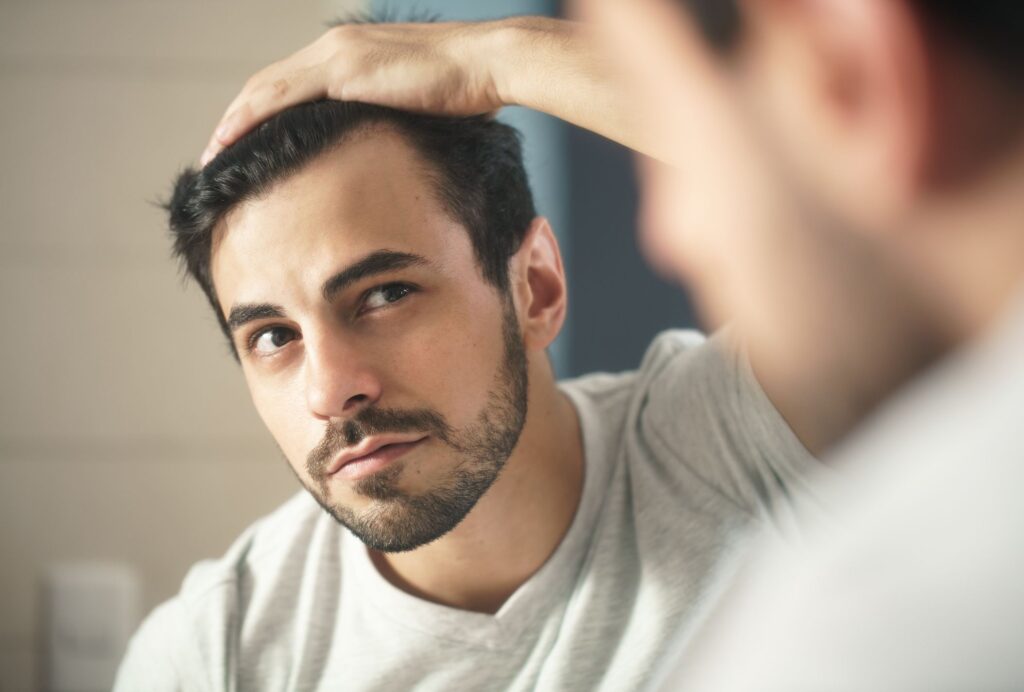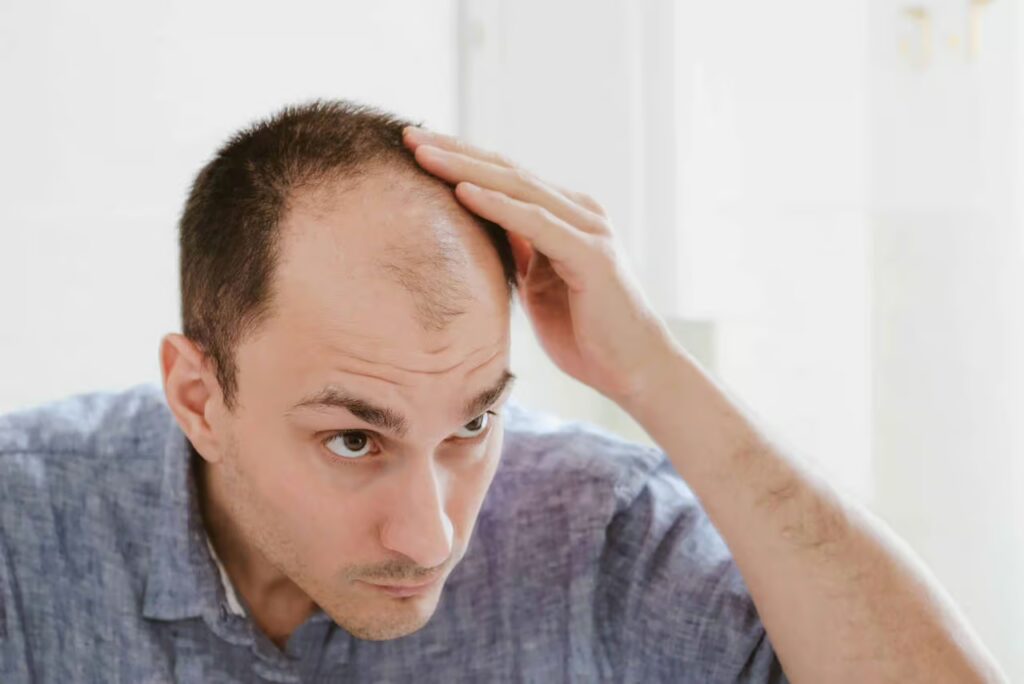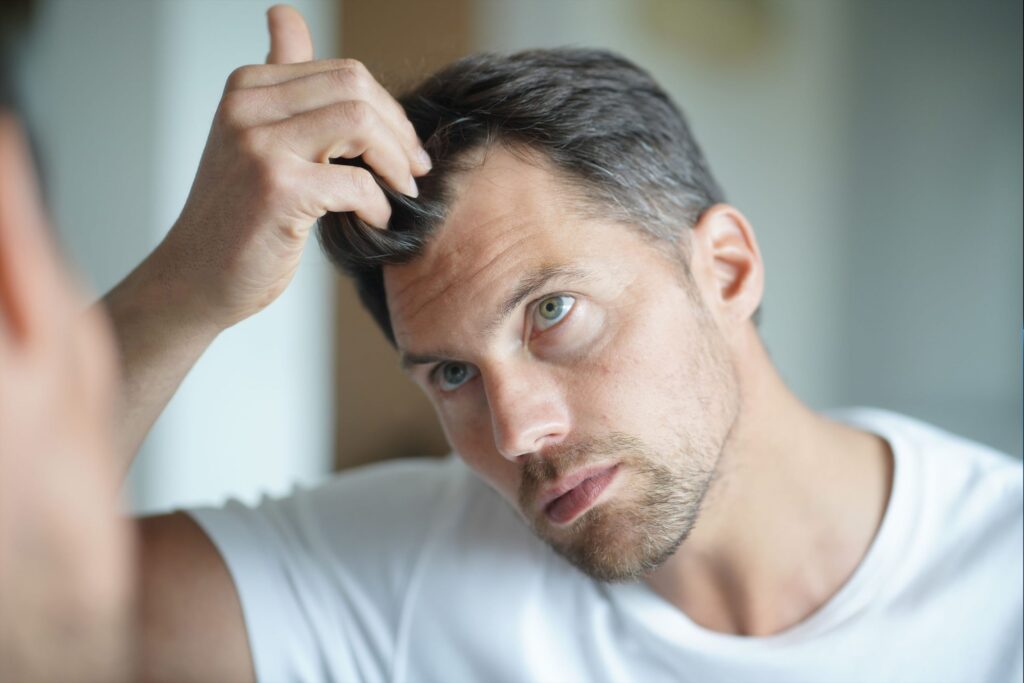Hair Loss treatment
6am - midnight, 7 days a week
Accessible from anywhere in Australia.
eScript in minutes
Medication delivery
What causes hair loss?
Hair loss can stem from various causes, and it’s important to distinguish between fact and fiction when understanding this issue. The primary factors contributing to hair loss include:
1. Heredity: Male-pattern baldness, or androgenetic alopecia, is the most common cause of hair loss in men. It is a hereditary condition where hair follicles become sensitive to dihydrotestosterone (DHT), a byproduct of testosterone, leading to gradual and predictable hair loss.
2. Medical Conditions: Certain medical conditions can trigger hair loss, particularly in women. Examples include alopecia areata (patchy hair loss), ringworm of the scalp (a fungal infection), and trichotillomania (hair pulling).
3. Medication: Some medications, including those for cancer, arthritis, depression, and heart issues, can contribute to hair loss. Chemotherapy and radiotherapy, for instance, are known to cause temporary baldness.
4. Stress: Stressful events can lead to temporary hair loss. While many people experience hair loss following stressful periods, this type of hair loss is generally temporary.
5. Hairstyles and Treatments: Hairstyles that pull the hair tightly, such as cornrows, can cause traction alopecia. Additionally, hot oil treatments, perms, and excessive bleaching can lead to inflammation and hair loss, which may become permanent if scarring occurs.
Hair Loss Treatment Options

Online Prescriptions
- For when your script has run out
- Script sent to your phone
- Doctor approved

Telehealth Consultations
- When you need to speak to a doctor
- Online, Video & Phone Call or Message
- Fast access to medical advice
Medical Certificates
- For when your script has run out
- Script sent to your phone
- Doctor approved

Hair Loss Symptoms
Hair loss, also known as alopecia, can manifest in various forms, including gradual thinning, receding hairlines, or bald patches. Common symptoms include excessive shedding of hair, noticeable thinning of hair volume, and changes in hair texture or quality. In some cases, hair loss may occur suddenly or in specific areas, such as the crown or temples, and may be accompanied by itching or irritation on the scalp.
Dangers of Hair Loss
While hair loss is often not a sign of a serious medical condition, it can have significant emotional and psychological effects. It can lead to feelings of self-consciousness, anxiety, or a decrease in self-esteem, particularly if it occurs at a young age or progresses rapidly. In some cases, hair loss may be associated with underlying health conditions such as thyroid disorders, nutritional deficiencies, or autoimmune diseases. Seeking medical advice is important for diagnosing the cause and finding appropriate treatment options, such as topical treatments, medications, or lifestyle changes, to manage and slow the progression of hair loss.

Need a Specialist Referral?Get Yours in a Few Simple Steps!
Skip the long clinic waits and get referred to a specialist in minutes. The process is fast, secure, and simple.
- Quick access to specialist referrals – no in-person appointments needed
- Telehealth consultations with trusted, licensed doctors
- Fast, reliable service – referrals sent directly to your chosen specialist
- Convenient and affordable healthcare from your home
- No hidden costs – just simple, upfront pricing
Frequently
Asked Questions
Diagnosing hair loss typically involves a physical examination and a review of medical history. A doctor may examine the scalp to check for signs of infection, scarring, or other conditions. In some cases, blood tests may be conducted to identify underlying health issues, such as thyroid dysfunction or anemia, that could contribute to hair loss. A scalp biopsy or a hair pull test may also be performed to determine the cause of the hair loss.
While some forms of hair loss, such as genetic pattern baldness, cannot be prevented, others can be mitigated with early intervention. Maintaining a healthy lifestyle, eating a balanced diet, and avoiding excessive stress can help prevent hair thinning. For those at risk of hair loss due to hormonal changes, medications or treatments can be prescribed to slow or stop the progression.
In some cases, hair loss can be reversed, especially if the underlying cause is treatable. For example, if hair loss is caused by nutritional deficiencies or a thyroid imbalance, addressing the issue may lead to hair regrowth. Treatments like minoxidil and finasteride can help promote hair growth in cases of androgenetic alopecia. However, in more advanced stages of hair loss, such as in male pattern baldness, it may be difficult to fully reverse the condition, but treatments can slow progression and improve appearance.
There are several treatment options for hair loss, depending on its cause. Over-the-counter treatments like minoxidil (Rogaine) are commonly used to stimulate hair growth and slow hair loss. For men, finasteride (Propecia) can be prescribed to block the hormone responsible for hair loss. In more severe cases, hair transplant surgery may be an option, where hair follicles are moved from one area of the scalp to another. Low-level laser therapy and platelet-rich plasma (PRP) injections are also being explored as options for encouraging hair regrowth.
Hair loss can sometimes indicate an underlying health issue, such as a thyroid disorder, autoimmune condition, or anemia. It can also be linked to stress or poor nutrition. However, in many cases, especially with male and female pattern baldness, hair loss is not a sign of a serious health condition. If hair loss is sudden, patches of baldness appear, or it’s associated with other symptoms like fatigue or weight changes, it’s important to see a doctor for a thorough evaluation.
Yes, stress can contribute to hair loss. Stress can trigger a type of hair loss known as telogen effluvium, where more hairs than usual enter the resting phase of the hair growth cycle, leading to shedding. Stress-induced hair loss is typically temporary, and hair often regrows once the stressor is removed. However, chronic stress can contribute to ongoing hair thinning, so managing stress through relaxation techniques and self-care is important for overall hair health.
A healthy lifestyle can help support hair health and potentially prevent excessive hair loss. Eating a balanced diet rich in vitamins and minerals, including iron, zinc, and vitamins A, C, and E, can promote strong hair. Avoiding harsh chemical treatments or excessive heat styling can reduce damage. Regular scalp massages to stimulate blood flow, exercising to improve circulation, and managing stress can also support healthy hair growth.


